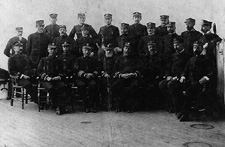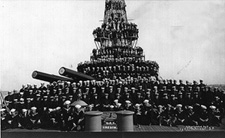
The below is a roster of the officers attached to the USS Oregon during the Spanish-American War campaign.

Capt. Charles E. Clark: Commanding Officer
Lieutenant Commander James K. Cogswell: Executive Officer, general charge of batteries
Lieutenant Reginald F. Nicholson: Navigator
Lieutenant Albert A. Ackerman: After 13 inch turret, 2nd Division
Lieutenant William H. Allen: in charge of ammunition supply
Lieutenant (jg) Edward W. Erberle: Forward 13 inch turret, 1st Division
Lieutenant (jg) Clarence M. Stone: 6 inch battery
Ensign Lucius A. Bostwick: range finder, torpedo officer
Ensign Charles L. Hussey: 6 pounder battery
Ensign Rufus Z. Johnston, Jr: Signal Officer
Captain of Marines Randolph Dickens: Officer-In-Charge of Marine Detachment, 6 pounder battery, 1 pounder battery
Naval Cadet Harry E. Yarnell: Port aft 8 inch turret
Naval Cadet Samuel G. Magill: 6 inch gun
Naval Cadet Clarence S. Kempff: Starboard aft 8 inch turret
Naval Cadet Paul B. Dugan: Forward 13 inch turret
Naval Cadet Everit J. Safler: Forward chain of supplies
Naval Cadet Edward C Kalbfus: After 13 inch turret
Naval Cadet Harry L. Brinser: After chain of supplies
Naval Cadet Charles B. Hatch: Second Battery
Naval Cadet Chauncey R. Shackford: Torpedo Division
Naval Cadet Overstreet: Starboard forward 8 inch turret
Chief Engineer Robert W. Milligan: In charge of Machinery
Past Assistant Engineer Cleland M. Offley: Starboard Engine Room
Assistant Engineer Joseph M. Reeves: Port Engine Room
Assistant Engineer Frank Lyon: In charge of Fire Rooms
Naval Cadet (Engineering Division) H. N. Jenson: After Hydraulic Pump Room
Naval Cadet (Engineering Division) William D. Leahy: Forward Hydraulic Pump Room
Assistant Engineer Thad C. Dunlap: Starboard Engine Room
Surgeon Phillips A. Lovering: Hospital
Assistant Surgeon Washington B. Grove: transportation of wounded
Paymaster Samuel R. Colhoun: aid to wounded
Chaplain Joseph P. McIntyre: aid to wounded
Pay Clerk Joseph A. Murphy: aid to wounded
Boatswain John Costello: Central Station
Gunner Arthur S. Williams: Powder Division
Carpenter Milton F. Roberts: in Powder Division
Of these officers, several would go on to serve as flag officers in the US Navy. These include:
- Capt. Charles Clark (1843-1922), would eventually attain the rank of rear admiral.
- Lt (jg) Edward Eberle (1864-1929), was promoted to rear admiral in 1918 and would eventually serve as Chief of Naval Operations (CNO) from 1923 to 1927.
- Naval Cadet William Leahy (1875-1959), was promoted to rear admiral in 1927. During World War II, Admiral Leahy served as the Chief of Staff to President Roosevelt and as Chairman of the Joint Chiefs of Staff. His 56-year naval career ended in 1949.
- Assistant Engineer Joseph Reeves (1872-1948), was promoted to rear admiral in 1927. During World War II, Admiral Reeves serve on numerous boards including the board that investigated the Pearl Harbor attack. His naval career ended in 1946 after 52-years.
- Naval Cadet Harry Yarnell (1875-1959), was promoted to rear admiral in 1928 and retired in 1939. Recalled to active duty for World War II, he retired again in 1944.

The list of enlisted personnel that served on the USS Oregon during the Spanish-American War is quite extensive and includes some 510 crew members including 65 marines that were permanently attached to the ship. Although the names do not appear here, the crew is the most valuable asset of the ship. Without them, the ship is nothing more than a piece of metal. The men came from all walks of life to live, work, and serve their country aboard this ship. Below is a listing of ratings (naval terminology for a job or person who performs that job) that were found aboard the USS Oregon. Although men were trained in specific jobs, anyone of the crew could be detailed to work or assist in any of the jobs that was necessary for the ship to accomplish its mission. This meant that seaman could (and did) man crew served weapons, such as ammunition handler for the 13" and 8" guns or serve on a damage control team. This still holds true for the United States Navy today. Sailors are trained in multiple tasks, so the ship can accomplish its mission. If the ships takes damage, everybody is a firefighter and repair worker.
Ratings that have initials next to them are rates that still exists in the navy today.
Apprentice (AA,FA,SA)*- Junior sailor who would assist with work around the ship. If this sailor stayed in the navy long enough, he would select a rate, such as Gunner's Mate, and this would be his new rating.
Boatswain Mate (BM)- Senior enlisted in this rate were in charge of all deck related operations, including ship preservation, boats launch and recovery, and lookout watches and navigation. This is still a Navy rate.
Blacksmith- Responsible for all metal reworking and repair. No longer a rating in the navy today.
Boilermaker (BT)- Maintenance and upkeep on ship's boilers and related equipment. In the navy today, these are Boiler Technicians.
Bugler- Sailor that made announcements via bugler calls.
Cabin Cook (MS)- Sailor who cooked for the Officers and Warrant Officers.
Carpenter's Mate (PM)- enlisted personnel in this rate were responsible for all wood repair and upkeep, including decks, boats, pilothouse. Now most closely related to the rate Patternmaker (PM), but skills are also used in the Damage Controlman (DC) rating.
Coal Passer- Men who fed the furnaces with the main form of fuel at that time: Coal. A tough and dirty job.
Coppersmith- Responsible for repair on copper tubing throughout the ship.
Coxswain (BM)- The small boat (or launches) pilots. Still a title in the navy, though not a official rating.
Fireman (FN)- Enlisted personnel in this rating maintained equipment in the ships firerooms. Today, any sailor below the rank of Petty Officer in Engineering Department.
Gunner's Mate (GM)- Enlisted men who maintained and operated all major weapons and associated equipment aboard the USS Oregon. This is still a navy rating.
Machinist (MM)- Enlisted men who maintained and operated the engines of the USS Oregon. Today, these sailors are called Machinist Mates
Master-at-Arms (MA)- Enlisted men who were responsible for maintaining order on the ship. Similar to policemen. Also maintained the ships small arms in conjunction with the Gunner's Mates.
Mess Attendant- Enlisted personnel assigned to assist the Ship's Cooks.
Oiler- Responsible for the lubrication of engineering equipment.
Painter- Enlisted personnel who maintained ships supply of paint.
Plumber and Fitter (HT)- Enlisted personnel who maintained and repair the ship's minor plumbing. Closely related with todays Hull Technician (HT).
Quartermaster (QM)- Personnel in this rating assist the navigator with ship's navigation. Also steered the ship from topside stations and battle stations.
Sailmaker- Enlisted personnel who maintained and repaired ship's canvas and awnings.
Seaman (SN)- Sailors assigned to perform topside exterior maintenance and preservation
Ship's Cook (MS)- Enlisted rates who prepared meals for the crew.
Shipwright- Enlisted rating who performed maintenance and repair on the ship's hull and structure. Also closely related to todays Hull Technician (HT).
Wardroom Steward- Prepared meals for the officers.
Water Tender- Enlisted rates who maintained boiler feed systems and associated equipment.
Yeoman (YN)- Enlisted personnel who maintain the official records and paperwork for the ship and crew.
* Today these are: Aviation Apprentice (AA), Fireman Apprentice (FA), and Seaman Apprentice (SA). Equivalent rank for all is grade E-2.
Marines were attached to the Oregon's crew and served as shore landing parties, shipboard security, and when the ship was engaged in combat at sea, these sea-soldiers manned guns. Marines, an armed service, attached to the Department of the Navy, have always worked closely with the Navy. Today, the Marines form an invaluable part of American defense and still serve aboard the Navy's capital ship that superseded the battleship: Aircraft Carriers.